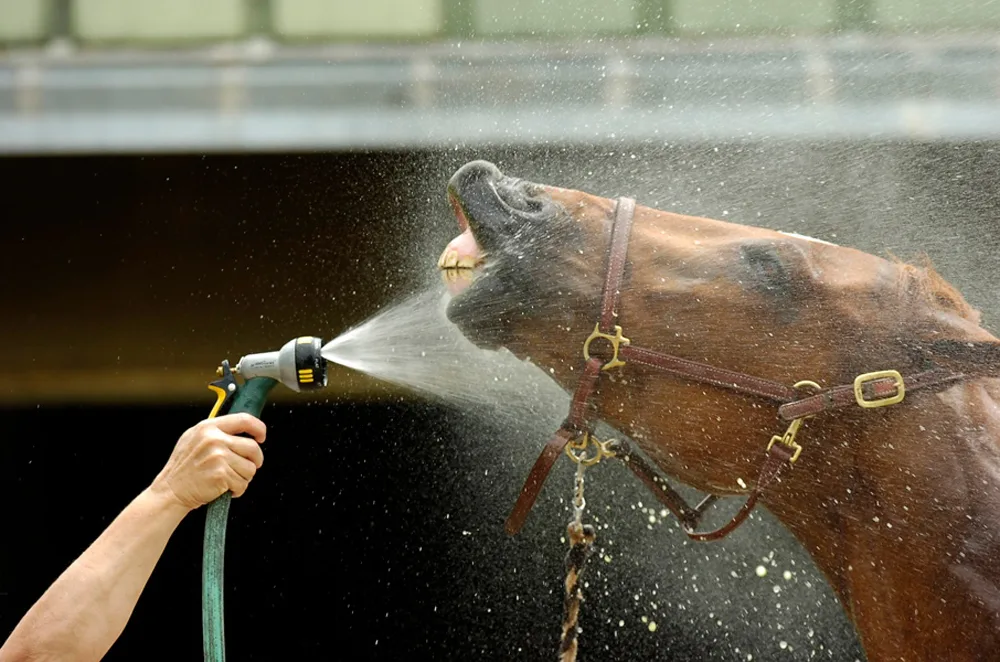Does your horse meet the prospect of a quick shower with delight or distaste? Chances are, he feels strongly about it. Washing his face can be a great experience for your horse, or it can result in a horrible accident. Like all things with horses, each individual will react differently to having his face washed. It’s our job as a caretaker to keep our grooming routines safe and effective. Liv Gude of Pro Equine Grooms has some suggestions.
Face washing is particularly tricky, in that many horses have adverse reactions to water on their faces, perhaps because of a fear of it entering their noses, ears, or eyes. It’s not out of the question for a horse faced with a water spray from a hose to panic and even flip over. But washing a horse’s face to remove sweat is essential. Often, we resort to chains, twitches or force out of frustration. I believe there is an easier way to train your horse to tolerate his face being washed, and it starts with baby steps.
Any time I introduce something new or different to horses, I work on the new concept for a few minutes every single day. I avoid making it an issue; if you weave it into your daily grooming routine, it doesn’t become a big deal. I always use positive reinforcement and end on a good note. Over time, you can incorporate increased intensity or duration and eventually you will be able to wash your horse’s face with a hose.
 |
| For horses who despise the hose near their face, a sponge and washcloth can be effective face-washing compromises. Photo by Liv Gude |
Also remember that not all horses are the same, and each one tends to have their “thing” that makes them unique. I have a horse that I am only able to sponge-wash his face, and there are many more horses who won’t tolerate a hose near their head. I worked for months on using the hose, but the hose near his face is his “panic and certain death thing.” So, we have a deal. I can sponge him until the cows come home, and he’s fine with that. If your horse makes it clear that the hose is a no-go for face-washing, respect that. Other horses have no issues whatsoever with hoses.
Ultimately, it would be awesome to just be able to spray your horse’s face with water and be done. Let’s assume you are not quite there yet. Where to start? First, your horse must tolerate your hand on all parts of his face and ears. Then you can move on to using a washcloth, soft brush, and sponges on his face. After you have mastered those items without a fuss and only using positive reinforcement, you can dampen the wash cloth, brush, or sponge. Then you can move on to work with the hose.
ADVERTISEMENT
The hose, or “water snake of doom” to some horses, needs some getting used to around the head. I will often let horses drink from a slow trickle, and then work on moving the hose (without water) around their faces. Any reaction of stillness should be rewarded. I find that having the hose come from behind across their cheeks is much more welcomed than having the hose come at them from the front. Again, take as much time as it takes with no water flowing until they are comfortable with this concept. Then you can add the slow trickle of water in.
When I reach a point where using the hose is second nature to the horse, I like to use a gentle shower spray or a slow trickle with a tiny bit of shampoo and a pimple mitt. Then rinsing is easy! Even if your horse is awesome with a hose on his face, it’s best to use the hose gently and consistently each time and to conscientiously avoid getting water in his ears. I typically work from the poll area down and the cheeks forward for best results. Remember to have safety come first, which may mean having a friend hold him instead of using cross ties. Be consistent, work at it every day, stay safe, and don’t make it a big deal. Over days, weeks, or months this will become part of your horse’s routine!
Do you have any grooming questions or mysteries you’d like answered? Email them to us, and Liv will address them next month!














